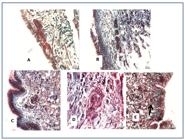Abstract
Biomphalaria amazonica is a planorbid species considered a potential host of Schistosoma mansoni. It is widely distributed in the Neotropical zone, particularly in the North and Centre-West of Brazil and in the North of Bolivia. The aim of the present study was to determine the host-parasite relationship between B. amazonica and S. mansoni (BH and SJ strains). Specimens of B. amazonica and their snail-conditioned water were examined in terms of their ability to attract miracidia. The infectivity of the mollusks was determined by exposing them to 20 miracidia of both strains. Sporocyst development and amebocyte reactions were studied after each mollusk specimen was exposed to 100 miracidia. Although no cercariae were eliminated, specimens of B. amazonica proved capable of attracting 77% of the miracidia they were exposed to. Viable sporocysts with no amebocyte reaction were found 96 hours after the exposure to miracidia. These results indicate the susceptibility of B. amazonica to the BH and SJ strains of S. mansoni, and therefore demonstrate the importance of this planorbid species as a potential vector of the trematode in the areas where it occurs.
Keywords:
schistosomiasis; susceptibility; BH strain; SJ strain

 Thumbnail
Thumbnail
 Thumbnail
Thumbnail
 Thumbnail
Thumbnail
 Thumbnail
Thumbnail



